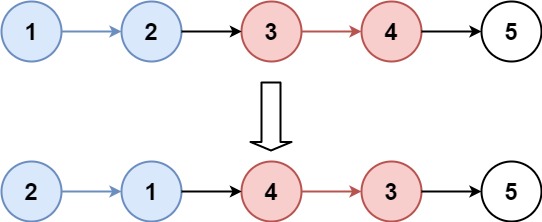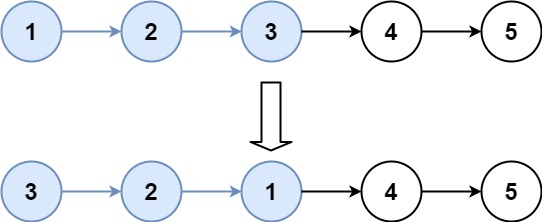📅Day-17 Striver’s SDE Sheet | Linked List Part 2 | Reverse a LinkedList in groups of size k, Check if the given Linked List is Palindrome.
 Payal Kumari
Payal Kumari
Note : Started my 27-day DSA journey with Striver’s SDE Sheet!
I will be journaling every day — recording what I learn, reflecting on it, and sharing it with my network to help fellow learners and aspiring developers.. Learning through videos, resources, and the internet — simplifying logic in my own way with real-world connections. Sharing 2 questions daily: brute-force to optimal, clean Java code, time & space complexity, and key patterns.
This blog series is for anyone preparing for coding interviews — whether you’re a beginner or a revision warrior. Let’s grow together! 🚀
Namaste Developers! 🙏
Welcome to Day 17 of my 27-day DSA journey using Striver’s SDE Sheet!
1️⃣ Reverse Nodes in k-Group
Given the head of a linked list, reverse the nodes of the list k at a time, and return the modified list.
k is a positive integer and is less than or equal to the length of the linked list. If the number of nodes is not a multiple of k then left-out nodes, in the end, should remain as it is.
You may not alter the values in the list's nodes, only nodes themselves may be changed.
Example 1:

Input: head = [1,2,3,4,5], k = 2
Output: [2,1,4,3,5]
Example 2:

Input: head = [1,2,3,4,5], k = 3
Output: [3,2,1,4,5]
Constraints:
The number of nodes in the list is
n.1 <= k <= n <= 50000 <= Node.val <= 1000
Follow-up: Can you solve the problem in O(1) extra memory space?
💠Real Life Example
Think of a group of friends standing in a line .
Photographer says: “Turn around in groups of k!”
If
k=2, every pair flips their position.If
k=3, every 3 friends swap positions.If the last group has fewer than
k, they just stay as they are (because photographer ka patience khatam).
(Hinglish : Socho ek group of friends line me khade hai.
Photographer bolta hai: “Turn around in groups of k!”
Agar k = 2, toh har 2 dost apni jagah swap kar lenge.
Agar k = 3, toh har 3 dost apni position ulat denge.
Agar last wale group me k se kam dost bache, toh wo waisa hi reh jaata hai (kyunki photographer ka patience khatam ho gaya) ).
class Solution { public ListNode reverseKGroup(ListNode head, int k) { if (head == null || k <= 1) return head; // Step 1: Traverse and store values in an ArrayList List<Integer> values = new ArrayList<>(); ListNode curr = head; while (curr != null) { values.add(curr.val); curr = curr.next; } // Step 2: Reverse every chunk of k elements for (int i = 0; i + k <= values.size(); i += k) { reverseChunk(values, i, i + k - 1); } // Step 3: Rebuild the linked list with modified values curr = head; int index = 0; while (curr != null) { curr.val = values.get(index++); curr = curr.next; } return head; } // Helper method to reverse elements in array between l and r private void reverseChunk(List<Integer> arr, int l, int r) { while (l < r) { int temp = arr.get(l); arr.set(l, arr.get(r)); arr.set(r, temp); l++; r--; } } }📍Complexity :
Time Complexity = O(N)
Space Complexity = O(N)
💠Optimal Approach
This is the real deal. We reverse the nodes by changing pointers, not values.
Steps:
Count total nodes.
While there are at least
knodes left:Reverse those
knodes using a standard linked list reversal technique.Connect the reversed group back to the previous part.
Move ahead
ksteps and repeat.
class Solution {
public ListNode reverseKGroup(ListNode head, int k) {
if (head == null || k == 1) return head;
// Dummy node to simplify handling of head reversals
ListNode dummy = new ListNode(0);
dummy.next = head;
ListNode prevGroupEnd = dummy;
ListNode curr = head;
while (true) {
// Step 1: Check if we have at least k nodes left
ListNode temp = curr;
int count = 0;
while (temp != null && count < k) {
temp = temp.next;
count++;
}
if (count < k) break; // not enough nodes, stop
// Step 2: Reverse k nodes
ListNode prev = null, next = null;
ListNode groupStart = curr;
for (int i = 0; i < k; i++) {
next = curr.next;
curr.next = prev;
prev = curr;
curr = next;
}
// Step 3: Connect reversed group with rest of the list
prevGroupEnd.next = prev;
groupStart.next = curr;
prevGroupEnd = groupStart;
}
return dummy.next;
}
}
📍Complexity :
Time: O(N) → Each node is visited once and reversed once.
Space: O(1) → In-place reversal, only a few pointers used.
(Hinglish : Soch lo ek line of friends khadi hai. Photographer bolta hai: “Har group of k, ulta ho jao!”
Agar exact group milta hai → ulta kar do.
Agar last group chhota hai → waisa hi rehne do.
👉 Brute force = notebook mein likh ke ulta karna (uses extra space).
👉 Optimal approach = bina likhe directly rotate karna (only pointers change). )
2️⃣ Palindrome Linked List
Given the head of a singly linked list, return true if it is a palindrome or false otherwise.
(Palindrome : A palindrome is a sequence that reads the same forward and backward.)
Example 1:

Input: head = [1,2,2,1]
Output: true
Example 2:

Input: head = [1,2]
Output: false
Constraints:
The number of nodes in the list is in the range
[1, 10<sup>5</sup>].0 <= Node.val <= 9
Follow up:Could you do it inO(n)time andO(1)space?
💠Real-Life Example
Think of a Palindrome Linked List like a Mirror.
Imagine writing a word on a folded paper.
When you unfold it → the left side and right side must look the same for it to be palindrome.
🔹 Example:
"RADAR" → Left = "RA", Right = "AR" (mirror hai, Palindrome).
"HELLO" → Left = "HE", Right = "OL" (mirror nahi hai).
In Linked List, we can’t just directly "look at the end" (no backward traversal in singly list). That’s why we use the reverse trick.
1️⃣Brute Force Approach
Idea:
Traverse the linked list → store values in an Array/List.
Check if the array is palindrome by comparing start and end.
class Solution {
public boolean isPalindrome(ListNode head) {
List<Integer> list = new ArrayList<>();
ListNode temp = head;
// Step 1: Copy linked list into array
while (temp != null) {
list.add(temp.val);
temp = temp.next;
}
// Step 2: Check Palindrome
int i = 0, j = list.size() - 1;
while (i < j) {
if (!list.get(i).equals(list.get(j))) {
return false;
}
i++;
j--;
}
return true;
}
}
💠Complexity :
Time Complexity:
O(n)Space Complexity:
O(n)
2️⃣Optimal Approach
📍Idea:
We’ll use Linked List tricks:
Find Middle of the linked list (slow-fast pointer method).
Reverse 2nd half of the list.
Compare 1st half and 2nd half.
(Optional: Restore the list back to original)
class Solution {
public boolean isPalindrome(ListNode head) {
if (head == null || head.next == null) return true;
// Step 1: Find middle
ListNode slow = head, fast = head;
while (fast != null && fast.next != null) {
slow = slow.next;
fast = fast.next.next;
}
// Step 2: Reverse 2nd half
ListNode secondHalf = reverse(slow);
// Step 3: Compare
ListNode firstHalf = head;
while (secondHalf != null) {
if (firstHalf.val != secondHalf.val) {
return false;
}
firstHalf = firstHalf.next;
secondHalf = secondHalf.next;
}
return true;
}
// Function to reverse linked list
private ListNode reverse(ListNode head) {
ListNode prev = null, curr = head, next;
while (curr != null) {
next = curr.next;
curr.next = prev;
prev = curr;
curr = next;
}
return prev;
}
}
💠Complexity :
Time Complexity:
O(n)Space Complexity:
O(1)
(Hinglish :
Brute Force → "Array banao aur check karo palindrome hai ya nahi."
Optimal → "Middle nikal lo → 2nd half reverse karo → dono half compare karo.")
✍️ Final Notes:
If you're just starting your DSA journey like me, don't worry if you don’t get it perfect the first time.
Visualize → Dry Run → Optimize.
Stay consistent, and let’s crack every problem from brute to optimal! 💪
🙏 Special Thanks
A heartfelt thank you to Rajvikraaditya Sir for creating and sharing such an incredible DSA resource with the community (takeuforward). Your structured approach has made DSA more accessible and less intimidating for thousands of learners like me.
If this helped you, do share it with your fellow DSA learners.
Comment with your doubts — I’d love to answer and grow together 🌱
✍️ Payal Kumari 👩💻
My 27-Day DSA Journey with Striver’s Sheet! #dsawithpayal

Subscribe to my newsletter
Read articles from Payal Kumari directly inside your inbox. Subscribe to the newsletter, and don't miss out.
Written by

Payal Kumari
Payal Kumari
I'm a passionate full-stack developer with a strong foundation in the MERN stack—building and maintaining scalable web applications using React.js, Node.js, and Next.js. My journey in open source began with Hacktoberfest 2023, where I made four impactful pull requests that sparked a love for collaborative coding, global learning, and open knowledge sharing. Since then, I’ve contributed to and mentored projects in top open source programs like GSSoC’24, SSOC’24, and C4GT’24. As a Google Gen AI Exchange Hackathon ’24 Finalist and Google’s Women Techmakers (WTM) Ambassador, I’ve been privileged to support diverse communities in building meaningful tech solutions. My work as a Top 50 Mentor for GSSoC ’24 reflects my commitment to nurturing new talent in tech. Beyond development, I serve as a Student Career Guide, Profile Building Expert & Evangelist at Topmate.io, where I conduct workshops, guide students through resume building and career strategy, and help mentees navigate open source and tech careers. Recognized among the Top 5% of mentors and featured on “Topmate Discover,” I take pride in making mentorship accessible and impactful. My technical voice has also been acknowledged by LinkedIn, where I’ve earned the Top Voice badge seven times in domains like web development, programming, and software engineering. In addition, I hold LinkedIn Golden Badges for Research Skills, Interpersonal Skills, Critical Thinking, and Teamwork—signaling a well-rounded approach to both individual contribution and team collaboration. Graduating with an MCA from Chandigarh University in 2023, I’ve continued to fuel my curiosity by writing technical articles and sharing practical MERN stack insights across platforms. Whether it’s building polished UIs, optimizing backend performance, or guiding a mentee through their first pull request, I’m driven by the power of community and continuous learning. Let’s connect! I'm open to collaborations, mentorship, or building something impactful together. Reach out to me at kumaripayal7488@gmail.com or visit my profile on Topmate.io.